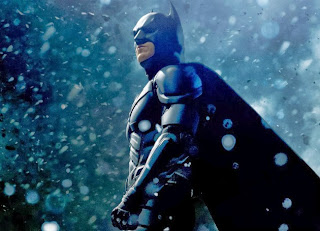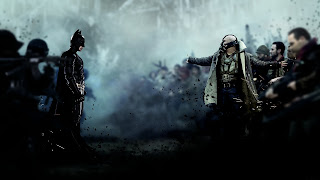★★★★
Birth of a Nation isn’t overtly hostile to its black
characters, but it sees them from a condescending, paternalist perspective. The black population in the film dances barefoot, plays music, laughs and eats chicken and watermelon, but the people themselves aren't portrayed as inherently anti-white. Much of the black/white tension in the film results from Northern whites manipulating the simple-minded blacks, though there is some resentment of whites in characters such as Stoneman’s housekeeper. Another element of the bigotry here is that some black men, like Silas and Gus, are unable to control their passion for white women, which leads to conflict. There aren't any workable interracial love interests here. And though Birth of a
Nation includes some positive positive black figures, these characters embody the
paternalistic attitude of the film in their own way -- Mammy and Jake are
contented servants willing to give their all for their white owners/employers. Because of the paternalism in Birth of a
Nation, the black characters don’t hate whites and don’t especially want to
dominate them; instead, the African Americans here aren’t able to think for
themselves and mostly take their cues from white ideologues who are bent on using
them to upend social convention.
When a film can have you rooting for the Ku Klux Klan to rescue
a group of white folks from a black military unit, you have to pay attention to
what’s been happening on the screen. And when that film is from 1915, there’s
even more cause. The paradox
of the repugnant racism which informs Birth of a Nation and the aesthetic
beauty and technical achievement of the film puts it on a very short list of
movies that make me uncomfortable to watch.
In a bad way. Like the anti-gay
bigotry of Rome, Open City and the aesthetic idealization of fascism in Triumph
of the Will, the pervasive racism in Birth of a Nation makes watching the film
today an ambivalent experience for me at best.
A striking thing about Griffith’s paternalistic racism is
that it doesn't imply that blacks need to be repressed. Birth of a Nation lauds Abraham Lincoln and
approves of his leadership in the Civil War and his freeing of the slaves in
the South. It goes on to show Lincoln as
trying to ease the reintegration of the South into the Union against hardcore
ideologues like Stoneman and opportunistic carpetbaggers. It’s these latter parties, who manipulate the
black population to their own advantage, that are the real villains in this
film. African Americans are too simple
to be responsible.
But aside from the racism that informs Birth of a Nation, the
film is clearly a giant step in film narration.
E.W. Porter may have pioneered basic elements of modern film like simultaneous story lines and continuity editing, but it’s Griffith – here – who turns these elements into what feels much like the language of cinema as we still know it today.
E.W. Porter may have pioneered basic elements of modern film like simultaneous story lines and continuity editing, but it’s Griffith – here – who turns these elements into what feels much like the language of cinema as we still know it today.
Early in Birth of a Nation, editing lays out simultaneous
stories as we visit the Stoneman family of Pennsylvania and the Camerons of the
Piedmont. The simultaneity here
contrasts life in the North and the South.
After the war begins, Birth of a Nation also cuts between battlefield
and home front, showing us what’s happening in those two spheres. But the real conceptual leap in this film is its suspenseful conclusion as we see the Klan rallying, Lynch trying to
force Elsie into marriage, and the Camerons being surrounded by a menacing black militia. All simultaneously. And Griffith doesn’t grant the audience
narrative relief until all three narratives are resolved. We worry as the Klan gathers, wondering if the riders will be in time to rescue Elsie, but then while the rescue of Elsie is underway, we
worry whether Ben will get the Klan to the countryside cottage to rescue the
Camerons. It’s this headlong narrative
drive that so engages viewers today that causes us to end up rooting for, of
all things, the Ku Klux Klan; this section of Birth of a Nation is a real
testimony to the power of the film language that Griffith masters here.
Modern viewers also recognize other cinema elements in the film that are
familiar to us. For example, Griffith
uses editing to portray a psychological state of mind. At one point, Margaret rejects a suitor as
she thinks back on her brother, and the director cuts from a shot of Margaret thinking
to one of her brother dying. This edit
evokes not only the brother’s death but Margaret’s pain over losing him and establishes her state of mind. And Griffith uses many now-standard cinema
gestures to create the scale and kinetic energy of a battlefield. A shot of a woman with her children morphs
into the introduction of a huge battle as the camera pans from a medium
close-up of the family unit on a hill and to a very long shot that reveals a
massive military assembly in the valley below.
Later, a matte insert combines scenes of Atlanta burning with frenetic
battlefield movement in the foreground to create an onscreen battle that not
only forecasts the same one in Gone with the Wind but also the large-scale SFX
work in movies like the Lord of the Rings trilogy. Birth of a Nation uses such cinematic elements
to put scale on the screen, but within such large-scale views, individual
vignettes give us the human element of war.
The young Cameron and Stoneman die together in battle, a scene
anticipating the melodrama that silent film would embrace so firmly, and there’s
even a tracking shot of the Little Colonel leading a charge that is shot from
the open bed of a truck ahead of the action.
The 1915, Birth of a Nation also anticipates other features
that would become cinematic stock-in-trade.
There is the engaging humor in the way the guard at the hospital pines for Nurse Elsie. His cute if futile gestures prefigure the Little Tramp as well as Buster Keaton. And we have a full blown action hero in the sexy, shirtless blacksmith who fights off everyone in saloon. It’s moving take on the action hero because, unlike today’s massive strongman hero, this one is ultimately shot in the back and killed, adding to our anger at the bad guys. It’s hard to imagine a similar end to a Bruce Willis or Jason Statham character. And Griffith even anticipates John Ford and David Lean in this film. The brief shot of a silhouette of horsemen on a hill could have been shot in Monument Valley or Wadi Rum decades later.
There is the engaging humor in the way the guard at the hospital pines for Nurse Elsie. His cute if futile gestures prefigure the Little Tramp as well as Buster Keaton. And we have a full blown action hero in the sexy, shirtless blacksmith who fights off everyone in saloon. It’s moving take on the action hero because, unlike today’s massive strongman hero, this one is ultimately shot in the back and killed, adding to our anger at the bad guys. It’s hard to imagine a similar end to a Bruce Willis or Jason Statham character. And Griffith even anticipates John Ford and David Lean in this film. The brief shot of a silhouette of horsemen on a hill could have been shot in Monument Valley or Wadi Rum decades later.
And I’m no expert, but I found the use of intertitles in the
film to be inconsistent and, for that reason, interesting. Some of them summarize and comment on the
action we've seen, and others give dialogue.
Among the most interesting are the ones aimed to shore up the
verisimilitude of the film. Some explain
that the way we see Ford’s Theater is the way it really was or that the tableau
we see of the surrender at Appomattox is an honest rendition of the historical
fact, complete with footnotes and references to sources. Beyond the intertitles, Griffith also aims at
being “realistic” by basing some scenes on Civil War photographs. The image of the rider on the black horse
with a wagon in the background echoes an image of Mathew Brady as do the images
of battlefield causalities.
All of which takes a viewer back to the uncomfortable paradox of this film -- the combination of its terrible racism with its breakthough discovery of powerful film language. Birth of a Nation is certainly one of the most difficult films films for a viewer to know how to respond to.



























